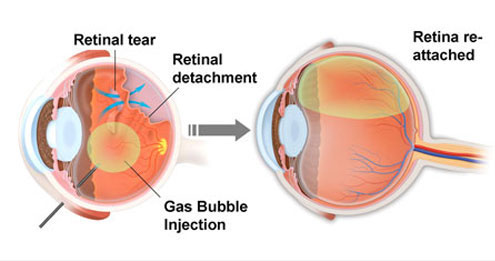
To view a PDF version of this information, click here.

In some cases, a retinal detachment can be repaired in the office using a procedure known as pneumatic retinopexy. This procedure involves injecting a small gas bubble into the eye in the office, and in select cases, can avoid a more invasive operating room surgery, such as a scleral buckle or vitrectomy. Because most retinal detachments originate from a tear in the retina, the principle behind pneumatic retinopexy is using a gas bubble to push the retina back and block the tear so fluid cannot continue to enter the tear and further detach the retina. If fluid from inside the eye cannot go through the tear, it cannot get behind the retina. Any fluid that is already behind the retina is gradually absorbed by the eye, and the retina reattaches to the wall of the eye. Laser retinopexy or cryotherapy (freezing treatment) is applied to the retinal tear either during or after pneumatic retinopexy to create small scars that will help "spot weld" the retina to the wall of the eye and prevent re-detachment.
Before your procedure, the doctor will perform a dilated retina examination. Then, you will be seated comfortably in the procedure room and anesthetic eye drops will be placed in your eye. Once the surface of the eye is numb, an anesthetic injection will be given on the surface of the eye to numb the deeper layers of the eye wall. It will take about 5 to 10 minutes for the numbing medicine to fully work, keeping your eye comfortable during the procedure. Your comfort is an important priority for our doctors and staff, and we will make every effort to ensure a pleasant experience. Typically, after the numbing takes effect, most patients report not feeling anything during the actual injection.
After the eye is anesthetized, an antiseptic solution is applied to the surface of the eye, the eyelashes, and the eyelids to sterilize the area. A small retractor is placed between the eyelids to help you avoid blinking during the procedure, and then a small gas bubble is injected into the eye. Because the eye is a closed space (like a tire or balloon), a second needle is used to remove a small amount of fluid from the eye so the pressure inside the eye remains the same. Your eye will then be rinsed and an antibiotic eye drop will be administered. Lubricating ointment will be placed in your eye, and a patch will be placed over it. The injection is painless and the entire procedure takes about 30 minutes.
If cryotherapy is required, it will be performed just before the gas injection, while your eye is anesthetized. Laser retinopexy may also be required one to a few days after pneumatic retinopexy. The use of a gas bubble will require that you position your head in a specific manner for a determined period of time-sometimes even up to two weeks after the procedure. The duration of head positioning will be determined by your doctor during and after the procedure and discussed with you.
Your doctor will discuss all of the above with you and review additional information and precautions before and after your treatment. Our goal is to have all of your questions answered, so please feel free to ask our Los Angeles Retina Specialists and staff about any questions or concerns you may have.

